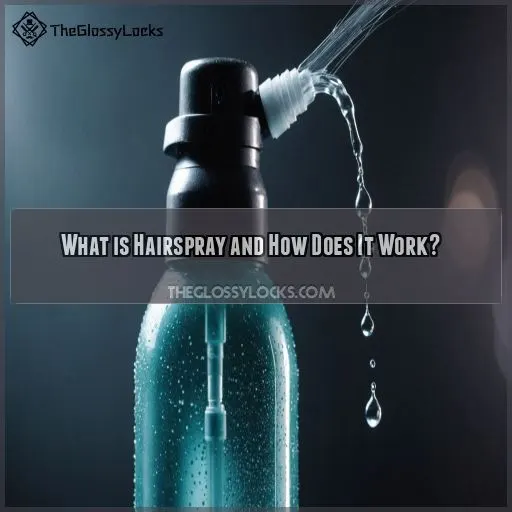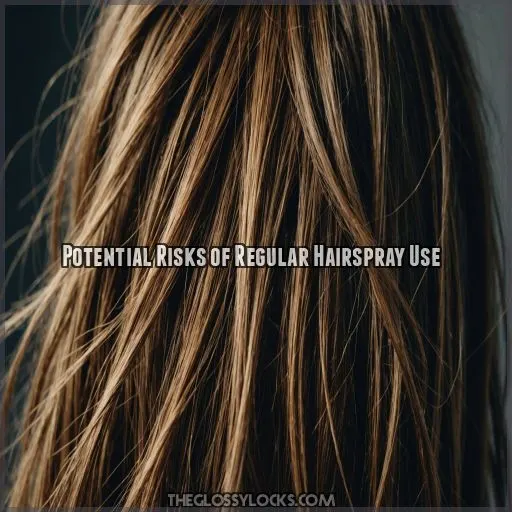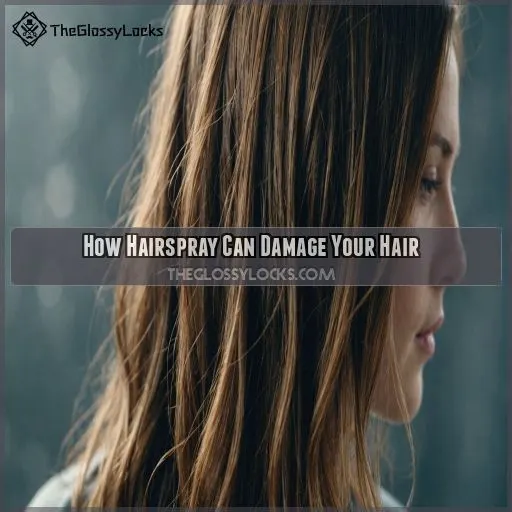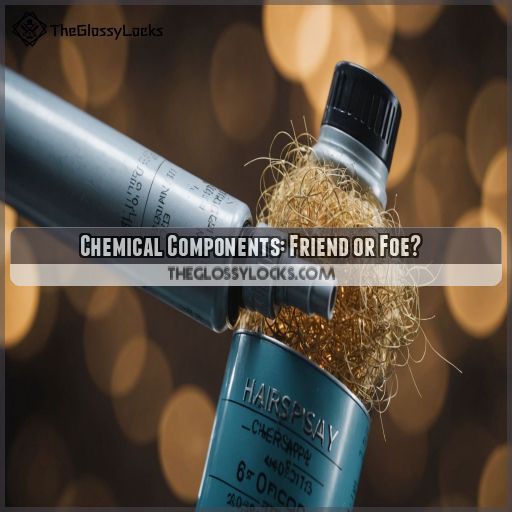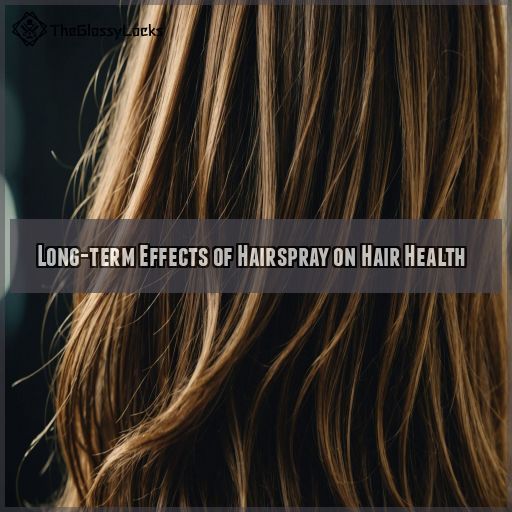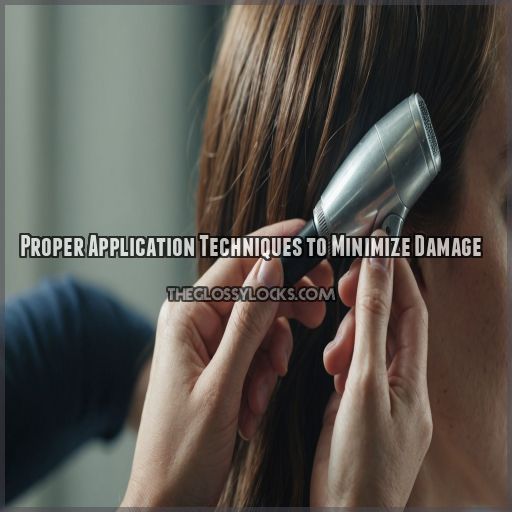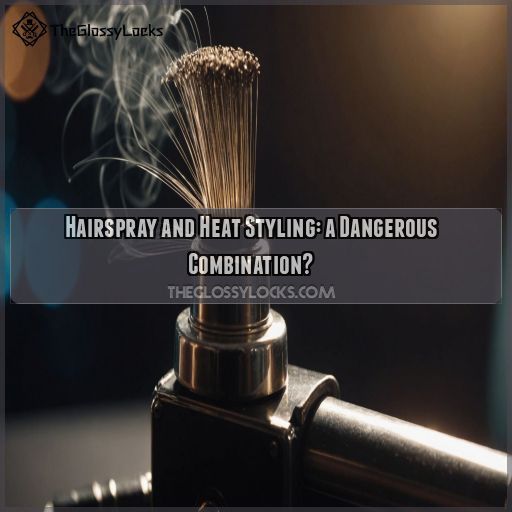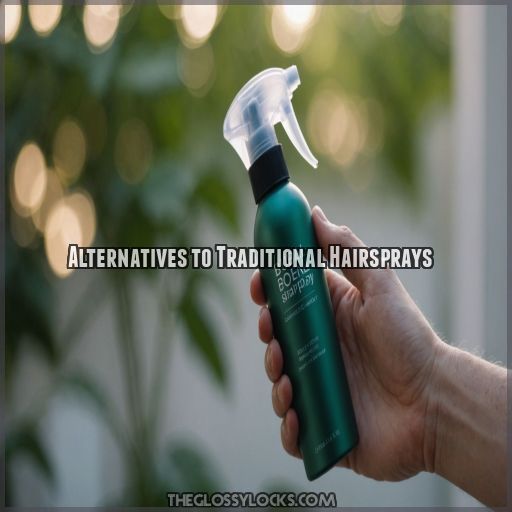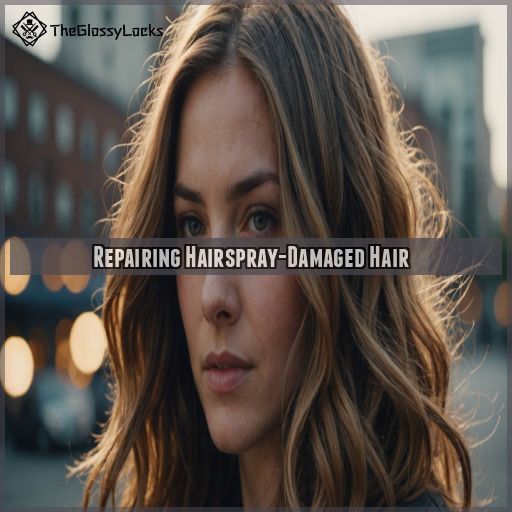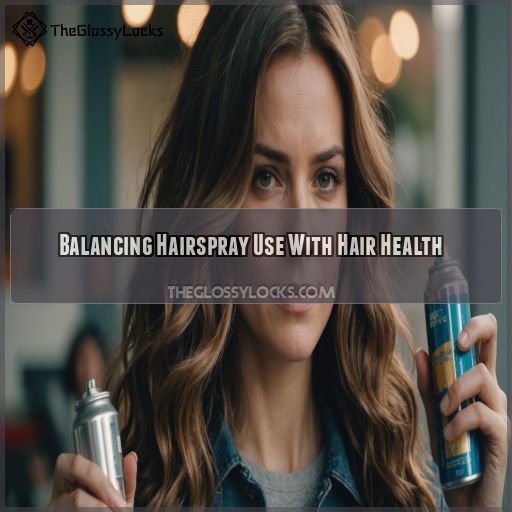This site is supported by our readers. We may earn a commission, at no cost to you, if you purchase through links.
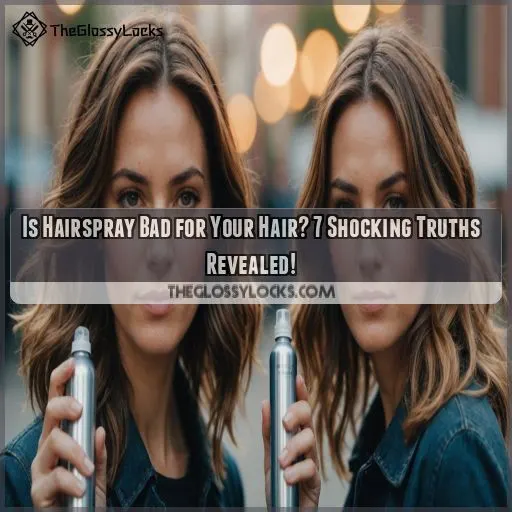 Is hairspray bad for your hair? Well, it’s not exactly your strands’ best friend, but it’s not the villain it’s sometimes made out to be.
Is hairspray bad for your hair? Well, it’s not exactly your strands’ best friend, but it’s not the villain it’s sometimes made out to be.
While hairspray won’t cause hair loss, it can lead to some pesky problems if you’re heavy-handed.
Think build-up, dryness, and brittle locks, like turning your mane into a crunchy helmet!
The key is moderation and proper application.
Use it sparingly, keep that can at arm’s length, and don’t forget to give your hair a break now and then.
With the right technique, you can rock that hold without turning your tresses into a tangled mess.
Curious about the shocking truths behind hairspray’s effects? You’re in for some hair-raising revelations!
Table Of Contents
- Key Takeaways
- What is Hairspray and How Does It Work?
- Potential Risks of Regular Hairspray Use
- How Hairspray Can Damage Your Hair
- Chemical Components: Friend or Foe?
- Long-term Effects of Hairspray on Hair Health
- Proper Application Techniques to Minimize Damage
- Hairspray and Heat Styling: a Dangerous Combination?
- Alternatives to Traditional Hairsprays
- Repairing Hairspray-Damaged Hair
- Balancing Hairspray Use With Hair Health
- Frequently Asked Questions (FAQs)
- Is it OK to use hairspray everyday?
- Is hairspray damaging to your hair?
- Does hairspray cause hair thinning?
- Is leaving hairspray in your hair bad?
- Can hairspray cause hair loss or thinning?
- Is it safe to use hairspray during pregnancy?
- How often should I wash out hairspray?
- Can hairspray affect hair color or highlights?
- Are there eco-friendly or biodegradable hairspray options?
- Conclusion
Key Takeaways
- You’re not doomed if you use hairspray, but don’t go overboard. Like that extra slice of pizza, moderation is key. Use it sparingly and give your locks a break now and then to avoid turning your mane into a crunchy helmet.
- Your application technique matters more than you might think. Keep that can at arm’s length (about 8-12 inches away) and aim for a light mist, not a downpour. It’s like watering a delicate plant – you want to nurture, not drown.
- Hairspray and heat styling are a risky duo, like mixing coffee and energy drinks. The residue can amplify heat damage, so consider using a heat protectant or exploring gentler styling alternatives. Your future self (and your hair) will thank you.
- Don’t panic if you’ve overdone it – your hair isn’t a lost cause. Treat your tresses to some TLC with deep conditioning treatments, protein-rich masks, and regular trims. Think of it as sending your hair to a spa day after a stressful week.
What is Hairspray and How Does It Work?
Ever wonder what’s in that magical mist that keeps your hair in place? Let’s uncover the secrets of hairspray, from its key ingredients to how it works its styling magic on your locks.
Key Ingredients in Hairspray
Ever wonder what’s in that magical mist that keeps your ‘do in place?
Hairspray’s key ingredients are like a chemistry set for your locks.
You’ve got polymers that act as the glue, propellants to create that fine mist, and fragrances to keep you smelling fresh.
But watch out for alcohol – it’s a common culprit in many formulas.
Some brands are stepping up with natural ingredients, giving you style without the guilt.
Mechanism of Hair Stiffening
- Polymer bonds form a flexible film around each strand
- This film holds hair in place without making it rigid
- The level of hold depends on the polymer concentration
It’s like giving your hair its own microscopic armor!
Historical Development of Hairspray
You might be surprised to learn that hairspray’s roots go way back to the 1940s!
Before the sleek cans we see today, early hairspray ingredients were a far cry from modern formulas.
Imagine your grandma using a pump spray filled with shellac and vegetable gums to keep her victory rolls in place.
Talk about sticky business!
Hairspray innovation took off as the beauty industry boomed, revolutionizing hair trends and fashion alike.
Types of Hairspray Holds
- Light hold: Perfect for fine hair or subtle styles, like those mentioned in this article
- Medium hold: Ideal for everyday looks and most hair types
- Strong hold: Your go-to for elaborate updos or battling humidity
Potential Risks of Regular Hairspray Use
Despite its popularity, regular hairspray use comes with potential risks you should be aware of. While it keeps your style in place, it might be doing more harm than good. Let’s break down some shocking truths about hairspray:
| Risk Factor | Short-Term Effects | Long-Term Consequences |
|---|---|---|
| Chemical Exposure | Scalp irritation, dryness | Allergic reactions, hair loss |
| Product Build-up | Dull, lifeless hair | Clogged hair follicles, thinning |
| Propellant Inhalation | Dizziness, headaches | Respiratory issues, skin problems |
You might think you’re in control of your hair, but overusing hairspray can lead to a hairy situation! It’s like putting your locks in a chemical straightjacket – sure, they’ll behave, but at what cost? Remember, your scalp is like a delicate garden. Bombarding it with harsh chemicals is like dousing your flowers with weed killer. So, before you reach for that can, consider the potential long-term effects on your crowning glory.
How Hairspray Can Damage Your Hair
You might love how hairspray keeps your style in place, but it’s not all smooth sailing for your locks. Let’s uncover the ways this styling staple could be secretly sabotaging your hair health, from drying out your strands to causing unwanted build-up.
Drying Effects on Hair Strands
Ever wonder why your hair feels like straw after using hairspray?
It’s not your imagination! The alcohol in many hairsprays can zap moisture from your locks faster than you can say "bad hair day." Use protective hairstyles to help protect your hair from damage
This drying effect leaves your strands thirsty and vulnerable, potentially leading to a frizzy fiasco.
But don’t panic! With the right approach, you can still achieve that perfect hold without turning your mane into a desert.
Build-up and Residue Issues
Ever wondered why your hair feels sticky and weighed down after using hairspray? It’s all about build-up and residue. When you use hairspray regularly, it can leave a stubborn film on your strands and scalp. This build-up:
- Makes your hair look dull and lifeless
- Attracts dirt and pollutants like a magnet
- Creates a barrier that prevents moisture from penetrating
Don’t worry, though – we’ve got some tricks up our sleeve to keep your locks fresh and fabulous!
Impact on Hair Follicles
Hairspray can clog up your hair follicles.
When you spritz hairspray, tiny particles can settle on your scalp, potentially blocking those precious follicles.
This buildup can lead to scalp irritation and even hinder healthy hair growth.
Think of it like suffocating your hair’s roots – not a pretty picture!
But don’t panic; with proper application and care, you can still rock that hold without compromising your follicle health.
Increased Brittleness and Breakage
Hairspray might keep your style in place, but it’s not all sunshine and roses for your locks.
Ever noticed your hair feeling like straw after using it?
That’s because hairspray can make your strands more brittle, leading to a hair-raising situation: increased breakage.
It’s like putting your hair in a rigid cage – sure, it stays put, but at what cost?
Those damaged cuticles and split ends aren’t doing you any favors.
Chemical Components: Friend or Foe?
You might think hairspray is your styling BFF, but have you ever wondered what’s really in that can? Let’s take a closer look at the chemical components of hairspray and uncover whether they’re truly friends or secret foes to your luscious locks.
Harmful Alcohols in Hairsprays
You’ve probably heard that alcohol in hairspray can be a hair villain.
But why?
Well, some alcohols in hairsprays are like tiny thieves, stealing moisture from your locks.
They can leave your hair feeling as dry as the Sahara Desert!
Not all alcohols are bad guys, though.
Some, like cetyl alcohol, actually moisturize.
It’s like a secret agent working undercover to protect your hair.
Propellants and Their Effects
Propellants are the unsung heroes of your hairspray can, but they’re not without controversy.
You might be surprised to learn that these gases do more than just shoot product onto your locks.
From environmental concerns to potential health risks, propellants pack a punch.
Some hairspray brands are switching to alternative propellants, but many still use volatile organic compounds.
It’s worth considering the long-term effects before you give your ‘do that extra spritz.
Fragrances and Potential Irritants
While hairspray might make you feel like a million bucks, those fragrances could be more foe than friend. Your scalp’s not a fan of irritants, and some scents pack a punch. Here’s what you need to know:
- Fragrance allergies can lead to itchy, flaky scalps
- Synthetic scents often contain hidden irritants
- Even natural fragrances can cause reactions in sensitive individuals
-
Unscented options are available for those with sensitive noses
Don’t let your hairspray be a wolf in sheep’s clothing – your locks deserve better!
Natural Vs. Synthetic Ingredients
While fragrances can irritate your scalp, let’s look at the big picture: natural vs. synthetic ingredients in hairspray. You might think natural is always better, but it’s not that simple. Here’s a quick comparison:
| Natural Ingredients | Synthetic Ingredients |
|---|---|
| Often plant-based | Lab-created |
| May cause allergies | Consistent quality |
| Eco-friendly | Longer shelf life |
| Limited hold | Stronger hold |
Long-term Effects of Hairspray on Hair Health
You might think hairspray is just a quick fix for flyaways, but its long-term effects can be more than meets the eye. Let’s uncover the surprising ways regular hairspray use could be impacting your hair’s health over time.
Hair Thinning Concerns
Like a silent thief, hairspray might be stealing your hair’s health. You’ve probably wondered if your go-to styling product is causing hair thinning. While genetics play a big role, excessive hairspray use can contribute to the problem. Here’s what you need to know:
- Buildup can clog hair follicles
- Harsh chemicals may weaken hair shafts
- Constant styling stress can lead to breakage
-
Overuse may disrupt natural hair growth cycles
Don’t panic! With proper use and care, you can still rock your favorite styles without sacrificing your luscious locks.
Scalp Irritation and Dryness
Ever feel like your scalp’s throwing a tantrum after using hairspray? You’re not alone.
The harsh chemicals in many hairsprays can leave your scalp feeling drier than a desert.
Over time, this dryness can lead to irritation, flaking, and even dandruff.
But don’t toss your favorite spray just yet! By choosing gentler formulas and giving your scalp some TLC, you can keep your style without sacrificing scalp health.
Changes in Hair Texture
Beyond scalp issues, hairspray can really alter your hair’s texture over time.
You might notice your once-silky locks becoming stiff and brittle.
That frizz control you love? It could be causing your strands to lose their natural bounce and volume.
Hairspray can leave a residue that builds up, making your hair feel rough and look lackluster.
It’s like your hair’s wearing a stiff, invisible coat that’s hard to shake off!
Impact on Hair Growth Cycle
You might think hairspray only affects your hair’s surface, but it can actually mess with your hair growth cycle.
Frequent use can clog follicles, potentially slowing down growth and even leading to hair thinning.
It’s like putting a roadblock on your scalp’s highway!
To keep your mane thriving, consider alternating hairspray with gentler styling products or natural options like vitamin E-rich hair oils.
Proper Application Techniques to Minimize Damage
You might think a quick spritz is all it takes, but proper hairspray application is an art form. Let’s explore some expert techniques to keep your locks looking fabulous without causing damage.
Correct Spraying Distance
Precision is key when it comes to hairspray application.
You’ve probably been caught in a cloud of hairspray before, coughing and sputtering.
To avoid this and minimize damage, hold that can at arm’s length – about 8-12 inches from your hair.
This best distance helps distribute the spray evenly without oversaturating your locks.
Think of it as giving your hair a light mist, not a drenching downpour.
Your strands will thank you!
Avoiding Over-application
You know that feeling when you’re a hairspray junkie, and your hair feels like a helmet? Yeah, that’s not good.
Overusing hairspray can lead to buildup, making your locks feel sticky and brittle.
As a hairspray connoisseur, you’ll want to use just enough to hold your style.
Importance of Even Distribution
For hairspray application, even distribution is key to avoiding a sticky situation. Think of your hair as a canvas – you want to create a masterpiece, not a mess! Uneven application can lead to:
- Crunchy, stiff patches that scream "I overdid it!"
- Frizzy areas that missed out on the hold party
- Visible product build-up that’ll have people wondering if you’ve showered
Removing Hairspray Properly
Even distribution is great, but let’s face it: getting hairspray out can be a real headache.
Don’t worry, though! You’ve got this.
Start by brushing your hair thoroughly to loosen up that stubborn residue.
Then, try a clarifying shampoo or a DIY solution like an apple cider vinegar rinse.
For extra stubborn spray, a bit of coconut oil can work wonders.
Hairspray and Heat Styling: a Dangerous Combination?
You might think hairspray and heat styling are a match made in hair heaven, but this combo could be doing more harm than good. Let’s uncover why using hairspray before heat styling might be a recipe for disaster and explore some safer alternatives to keep your locks looking fabulous.
Increased Heat Damage Risk
You’ve mastered the art of hairspray application, but hold your horses!
There’s a hidden danger lurking in your styling routine.
When you combine hairspray with heat styling tools, you’re playing with fire – literally!
The residue from your trusty spray can act like a conductor, amplifying the heat and potentially frying your locks.
It’s like turning your blow dryer into a mini flamethrower for your hair!
Alternative Styling Methods
Wave goodbye to hairspray and heat styling! Your locks will thank you for exploring gentler alternatives. Here are some chic options to keep your mane in check:
- Embrace the natural look with sea salt spray for beachy waves
- Opt for protective styles like braids or updos secured with scrunchies
-
Add volume and shine with hair oil or aloe vera gel
These methods reduce damage and give you a break from harsh chemicals. Plus, you’ll rock that effortless, "I woke up like this" vibe!
Heat Protectants and Hairspray
Now, let’s talk about heat protectants and hairspray — a combo that might make your hair stylist cringe!
While you’re reaching for that trusty can of hold, don’t forget about your hair’s heat shield.
Mixing hairspray with heat styling tools is like playing with fire — literally! You’re risking double the damage.
But don’t worry, there’s hope. Heat protectants can be your hair’s best friend in this sticky situation, especially when you’re using hot styling tools.
Choosing the Right Products
If you want to protect your hair from heat damage, choosing the right products is key. You wouldn’t put on a thin jacket in a snowstorm, so why use weak protection for your precious locks? Here’s what to look for in heat-friendly hairsprays:
- Lightweight formulas that won’t weigh hair down
- Heat-activated polymers for extra protection
- Nourishing ingredients like argan oil or keratin
- Alcohol-free options to prevent drying
Alternatives to Traditional Hairsprays
If you’re worried about the effects of traditional hairsprays, you’re not alone. Luckily, there are plenty of alternatives that can give you the hold you need without compromising your hair’s health.
Natural Styling Products
You’ve seen how hairspray and heat styling can be a recipe for disaster.
But don’t worry, there’s a silver lining!
Natural styling products are the hairspray game-changers you’ve been waiting for.
These plant-based hairsprays are gentle on your locks and the environment.
They’re packed with nourishing ingredients that’ll make your hair say "thank you" instead of "ouch."
Ready to join the hairspray revolution?
Let’s explore some eco-friendly options that’ll keep your style on point!
DIY Hair Setting Sprays
You can make your own DIY hair setting sprays at home!
It’s like becoming a hairspray pioneer in your kitchen.
Mix water, sugar, and a dash of vodka in a spray bottle for a simple hold.
Or try aloe vera gel and water for a nourishing option.
These homemade concoctions give you control over ingredients and strength.
Leave-in Conditioners With Hold
Ditch the hairspray and embrace leave-in conditioners with hold! These multitasking marvels offer the best of both worlds:
- Moisture-rich formulas to nourish your locks
- Gentle holding power for all-day styles
-
Natural ingredients that won’t dry out your hair
You’ll love how these alternatives keep your ‘do in place while giving your tresses some TLC. It’s like having a personal hair stylist and moisturizer in one bottle. Say goodbye to crunchy, brittle strands and hello to soft, manageable hair!
Texturizing Powders and Mousses
If you’re looking to ditch the hairspray, texturizing powders and mousses are your new best friends.
These hairspray alternatives offer volume and hold without the crunch.
Powders absorb oil and add grit, while mousses create body and definition.
They’re gentler on your locks, reducing the hair health impact of traditional sprays.
Plus, they’re trending on social media – influencers can’t get enough of these texture-boosting styling tips!
Repairing Hairspray-Damaged Hair
If you’ve gone a bit overboard with hairspray, don’t worry – your locks aren’t doomed forever. With the right care and treatments, you can nurse your hair back to health and restore its natural shine and bounce.
Deep Conditioning Treatments
Struggling with hairspray-damaged locks? Deep conditioning treatments are your hair’s best friend.
These moisture-packed saviors can breathe new life into your stressed strands.
Whether you’re rocking hair extensions or battling the aftermath of colored hairspray, a good deep conditioner works wonders.
Even trusty Head and Shoulders offers options!
Protein-rich Hair Masks
Protein-rich hair masks are your hair’s best friend after a battle with hairspray. These nourishing treatments can help repair damaged strands and restore your locks to their former glory. Here’s why they’re a game-changer:
- Strengthen weakened hair shafts
- Improve elasticity and reduce breakage
- Replenish lost nutrients
You’ll find plenty of DIY hair mask recipes online, but for seriously damaged hair, consider a professional-grade treatment. Remember, consistency is key – treat your tresses to a protein boost once a week for best results.
Trimming and Maintenance
While protein masks work wonders, don’t forget the power of a good trim!
Regular haircuts are your secret weapon against hairspray damage.
You’ll bid farewell to those pesky split ends and give your locks a fresh start.
Think of it as a reset button for your hair.
Plus, who doesn’t love that "just left the salon" feeling?
It’s like giving your hair a mini-vacation from all that styling stress!
Scalp Care for Hair Health
Your scalp is the foundation for healthy hair, especially when recovering from hairspray damage. Think of it as the soil in which your hair grows. To nurture this important ecosystem:
- Gently exfoliate with a scalp scrub to remove product buildup
- Use a nourishing scalp oil to moisturize and soothe irritation
- Massage your scalp regularly to boost circulation and promote hair growth
Balancing Hairspray Use With Hair Health
Wondering if your hairspray habit is hurting your locks? Let’s explore how to keep your style on point without sacrificing your hair’s health, from smart usage tips to gentler product choices.
Frequency of Use Guidelines
Ever feel like you’re caught in a "hairspray cycle"? You’re not alone!
While it’s tempting to reach for that can daily, moderation is key.
Aim for occasional use, limiting yourself to 2-3 times a week. This sweet spot helps maintain your style without risking damage.
Choosing Gentler Formulations
With a dash of care, you can choose gentler hairspray formulations that won’t wage war on your locks. Here’s what to look for:
- Natural ingredients (think aloe vera and chamomile)
- Organic hairsprays free from harsh chemicals
- Cruelty-free options for the animal lovers
- Sulfate-free formulas to maintain moisture
- Low-alcohol options to prevent drying
Incorporating Protective Hair Care
Now that you’ve chosen gentler hairsprays, let’s talk about nurturing your locks. Incorporating protective hair care is like giving your tresses a suit of armor. You’ll want to build a routine that shields your hair from the potential pitfalls of hairspray use. Here’s a quick guide to help you out:
| Protective Measure | Benefit |
|---|---|
| Weekly hair masks | Deep conditioning |
| Scalp massages | Promotes hair growth |
| Heat protectants | Prevents damage |
| Regular trims | Removes split ends |
| Silk pillowcases | Reduces friction |
When to Avoid Hairspray Altogether
Hairspray can be a helpful styling tool, but it’s not always the best choice for everyone.
If you have scalp conditions or hairspray allergies, you should avoid using it.
It’s also best to choose gentler alternatives if you are pregnant or have fine, delicate hair.
Save hairspray for special events and give your hair a break in between.
Your hair type also matters, as some hair types don’t respond well to hairspray’s hold.
Frequently Asked Questions (FAQs)
Is it OK to use hairspray everyday?
You shouldn’t use hairspray daily. It can dry out your locks and lead to buildup. Give your mane a break every few days. When you do use it, apply sparingly and wash it out thoroughly.
Is hairspray damaging to your hair?
Imagine this: you’ve used hairspray daily for months, and now your locks feel like straw. While not inherently damaging, overuse can dry out your hair. Use it sparingly, and you’ll keep your mane healthy and fabulous.
Does hairspray cause hair thinning?
While hairspray itself doesn’t directly cause hair thinning, overuse can lead to breakage and damage. You’re better off using it sparingly and washing it out regularly to keep your locks healthy and voluminous.
Is leaving hairspray in your hair bad?
Leaving hairspray in overnight can be a sticky situation for your locks. You’ll wake up to dry, tangled hair that’s begging for moisture. It’s best to wash it out before hitting the pillow, keeping your mane happy and healthy.
Can hairspray cause hair loss or thinning?
While hairspray typically won’t cause hair loss directly, excessive use can lead to breakage and thinning. You’re better off using it sparingly and washing it out regularly. Think of it as a temporary style-booster, not a daily necessity.
Is it safe to use hairspray during pregnancy?
While hairspray’s generally safe during pregnancy, it’s wise to use it sparingly. Opt for low-VOC or natural options to minimize chemical exposure. Always spray in well-ventilated areas and avoid inhaling fumes. When in doubt, consult your doctor.
How often should I wash out hairspray?
Like untangling a stubborn knot, washing out hairspray shouldn’t be a daily battle. You’ll want to cleanse your locks every 2-3 days to prevent product buildup. Don’t let your mane become a sticky situation!
Can hairspray affect hair color or highlights?
Hairspray can impact your color or highlights, but it’s not all doom and gloom. Some sprays might leave a residue that dulls your hue, while others contain alcohol that can fade color. Choose wisely, and you’ll keep your locks looking vibrant!
Are there eco-friendly or biodegradable hairspray options?
You’re in luck! There are eco-friendly hairspray options hitting the market. Look for products with natural, biodegradable ingredients and sustainable packaging. These greener alternatives can help you style your hair while reducing your environmental footprint.
Conclusion
So, is hairspray bad for your hair?
It’s not exactly a hair hero, but it’s not the villain it’s sometimes painted to be.
When used wisely, hairspray can be your styling sidekick without turning your tresses into a tangled mess.
Remember: moderation is key.
Embrace proper application techniques, give your locks some TLC, and don’t shy away from exploring gentler alternatives.
With these tips in mind, you can achieve that perfect hold without compromising your hair’s health.
Keep your style on point and your strands happy!

